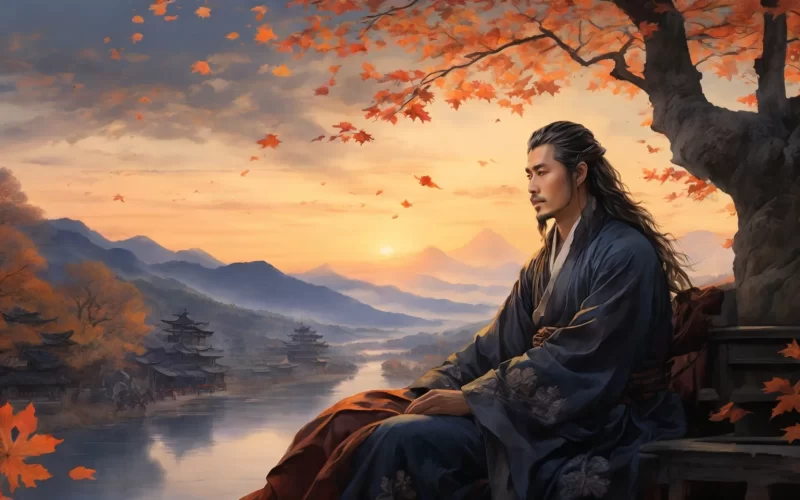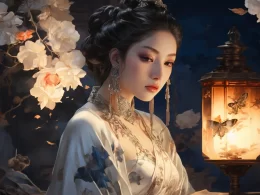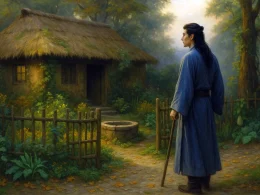You ask me when I am coming. I do not know.
I dream of your mountains and autumn pools brimming all night with the rain.
Oh, when shall we be trimming wicks again, together in your western window?
When shall I be hearing your voice again, all night in the rain?
Original Poem
「夜雨寄北」
李商隐
君问归期未有期,巴山夜雨涨秋池。
何当共剪西窗烛,却话巴山夜雨时。
Interpretation
Composed in 848 AD during Emperor Xuanzong's Dazhong era, this poem was written when Li Shangyin, stranded in the remote Ba-Shu region far from home and frustrated by career setbacks, poured out his profound longing for his wife in the north on an autumn night of incessant rain. More than just an intimate epistle to his beloved, it has become one of Chinese literature's most celebrated love poems. Using the night rain as metaphor, the poet sketches his solitary sojourn before envisioning future reunion, creating an emotionally resonant work that lingers in the reader's mind.
First Couplet: "君问归期未有期,巴山夜雨涨秋池。"
Jūn wèn guī qī wèi yǒu qī, bā shān yè yǔ zhǎng qiū chí.
You ask when I'll return - no date is set / While night rain floods Ba's autumn pools unmet
The opening dialogue immediately establishes poignant intimacy. The wife's question about his return ("you ask") carries tender expectation, while his indefinite reply ("no date") reveals the traveler's helpless frustration. The repetition of "期" (date/expectation) masterfully intertwines their mutual yearning with life's unpredictability.
The concrete image of Ba Mountain's autumn rain swelling the ponds serves multiple symbolic purposes. The Sichuan basin's characteristic night rains mirror the poet's unceasing melancholy, while rising water levels suggest accumulating sorrow. This deceptively simple nature sketch - where meteorological phenomenon becomes psychological landscape - demonstrates classical Chinese poetry's supreme fusion of scene and emotion.
Second Couplet: "何当共剪西窗烛,却话巴山夜雨时。"
Hé dāng gòng jiǎn xī chuāng zhú, què huà bā shān yè yǔ shí.
When shall we trim wicks by west window light / And recall this Ba Mountain rainy night?
The poet shifts from present melancholy to imagined future consolation. The elegant "trimming wicks" image - a traditional symbol of marital intimacy and nocturnal conversation - transforms their current separation into anticipated reunion material. Remarkably, the very "Ba Mountain rainy night" causing present loneliness becomes fodder for future nostalgic sharing, demonstrating Li's genius for temporal layering.
This couplet's circular structure is particularly ingenious: the night rain changes from immediate sensory experience to future conversational topic, making the present moment both the subject and object of remembrance - a metaphysical twist that anticipates modernist narrative techniques.
Holistic Appreciation
Centering on the theme of uncertain homecoming, the poem progresses from present sorrow to envisioned solace. Li Shangyin employs a spiral structure: beginning with direct dialogue, expanding through scenic melancholy, then ascending to imagined reunion. The seemingly straightforward four lines contain sophisticated temporal dimensions where past, present and future interweave.
The poem's apparent simplicity belies profound artistry. The auditory image of rain pattering on autumn ponds, the visual contrast between solitary night and future shared candlelight, create a quietly powerful emotional landscape. The "Ba Mountain night rain" operates both as literal phenomenon and metaphorical placeholder for separation, achieving what modern critics might call "stream of consciousness" through classical poetic techniques. This seamless blending of reality and imagination gives the compact verse remarkable depth.
Writing Characteristics
- Dialogic Intimacy: The opening question-answer format establishes immediate emotional authenticity and reader engagement.
- Scene-Emotion Fusion: Ba Mountain's rains simultaneously describe environment and embody sorrow, exemplifying classical poetry's "情景交融" ideal.
- Temporal Circularity: The night rain transforms from present experience to future reminiscence, creating a sophisticated time loop.
- Lucid Profundity: Unadorned language conveys rich emotional layers, proving that poetic elegance need not rely on ornate diction.
Insights
This rain-soaked poem transcends its Tang dynasty context to speak universally about separation and connection. It reminds us that longing bridges distances - that physical absence can nurture emotional presence. The poet's faith in future reunion ("when shall we…") offers hope that present loneliness will become material for future shared memory.
Moreover, the work exemplifies classical Chinese poetry's unique aesthetic: profound emotions expressed through subtle natural imagery, personal feelings universalized through artistic restraint. In just 28 characters, Li Shangyin demonstrates how great poetry can compress time and expand meaning, making individual experience resonate across centuries. The "Ba Mountain night rain" continues to fall in readers' imaginations, proving that true artistic creation outlasts both dynasties and individual lives.
Poem translator
Kiang Kanghu
About the poet

Li Shangyin (李商隐), 813 - 858 AD, was a great poet of the late Tang Dynasty. His poems were on a par with those of Du Mu, and he was known as "Little Li Du". Li Shangyin was a native of Qinyang, Jiaozuo City, Henan Province. When he was a teenager, he lost his father at the age of nine, and was called "Zheshui East and West, half a century of wandering".











